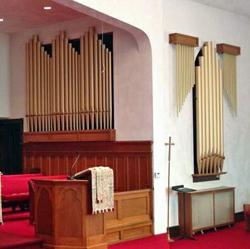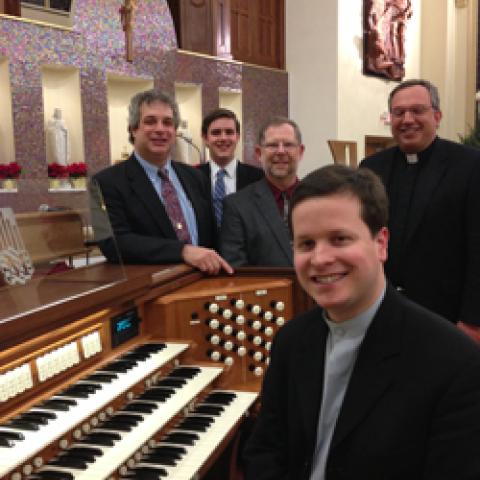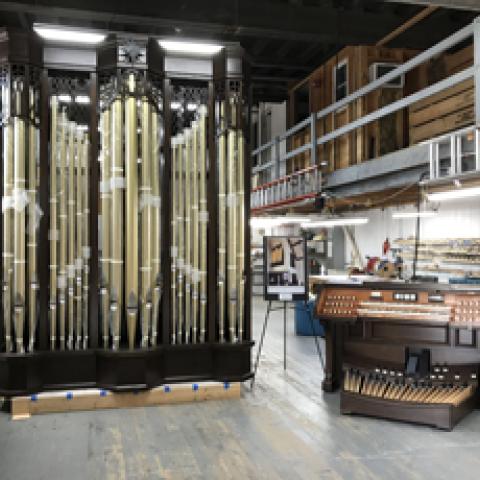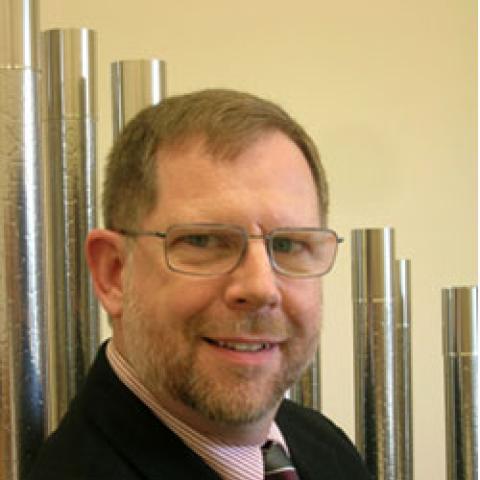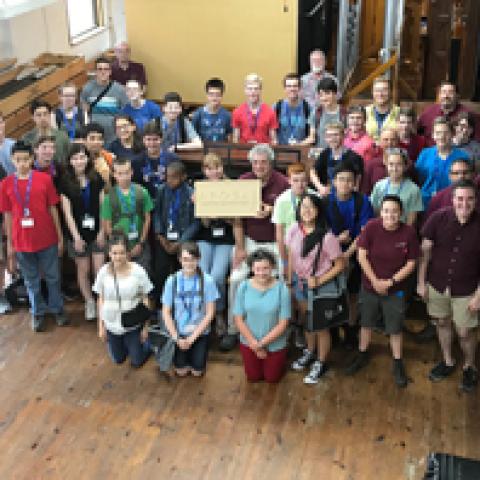John-Paul Buzard Pipe Organ Builders, Champaign, Illinois
First Presbyterian Church,
Lexington, Kentucky
From the organ builder
Organ projects take a long time. In the case of this undertaking, it can perhaps be said that this project has taken 110 years! It was in 1897 that the W. W. Kimball Co. of Chicago installed a two-manual and pedal tubular pneumatic action pipe organ in First Presbyterian Church. In 1936, Kimball revisited their then 40-year old instrument, converting the action to electropneumatic action and making some minor tonal changes. Subsequent alterations and repairs, not up to the quality of the original work, led to the decision to pursue a comprehensive rebuilding.
It was in May 2004 that Buzard Pipe Organ Builders first inspected the organ and met with the church’s organ committee. Our enthusiasm for the project and approach to the particular requirements of the project were a good fit with the church’s desires, and after jointly refining our vision a contract was signed on June 6, 2005 for a complete rebuilding of the church’s pipe organ. The organ was removed to the Buzard factory in February 2006, with re-installation beginning just about a year later and taking about two months on site.
This project is not a restoration. Many changes had already been made to the instrument over its first 100 years, and although the organ made some nice sounds, it could not provide the full tonal palette that is desired for what this instrument is called upon to do. In addition, the mechanical systems of the organ were neither in good condition nor adaptable to the tonal changes being made.
The new wind system retains and supplements the original Kimball reservoirs and tremolos, with new wooden wind trunks throughout the organ. A completely new console and switching system have been crafted, incorporating preparations for future installation of an Antiphonal division in the gallery (the location of the church’s first pipe organ).
New electric pull-down slider and pallet windchests have been constructed for the straight manual stops, and new electropneumatic action windchests have been constructed for the unit stops. A new building frame and structure has been constructed behind the original casework, with new enclosures incorporating the Kimball shutter frames.
Twenty-five stops of Kimball pipework have been retained, supplemented with 11 ranks of new pipework. All of the existing pipes have been carefully repaired and revoiced, and all the new pipes were custom scaled and built for this project under the watchful eyes (and ears) of the Buzard Company’s tonal director, Brian K. Davis, with all tonal finishing completed on site by Mr. Davis and Mr. Buzard. The visible façade pipes, containing basses of the 16′ and 8′ Diapasons, have been brilliantly decorated using the original patterning.
The organ is now in as-new condition, ready to sound forth in its second century with both bold new voices and sounds that echo from its past. Everything old is new again!
—Keith Williams and David Brown
Buzard Pipe Organ Builders
Service Department
From the organ consultant
In March 2004, I was invited by the director of music and arts, Marlon Hurst, to advise the organ committee of the First Presbyterian Church with regard to their organ. On visiting the church, I found a rather decrepit instrument, originally built in 1897 by the noted Kimball firm, which had subsequently been repaired, patched, altered and added to on several occasions by various people. Kimball had electrified the action (originally tubular) and replaced the console in 1936, but both action and console were now rapidly deteriorating, resulting in dead notes, loose pedal keys, and an erratic combination action. Examination of the interior revealed obsolete windchests, a patchwork electrical system with components ranging from the 1936 electrification to recent solid-state, a replacement (and slow) swell shade motor, inoperative top-note pedal extensions, leaky windlines patched with duct tape, recently recovered reservoirs and winkers, and evidence of some re-leathering of primaries.
Even visually, the organ had been changed, the casework darkened, and the display pipes (along with much of the rest of the church interior) painted a dull off-white to match the sanctuary’s then rather drab interior. Tonally, there had been a few substitutions, along with various additions and extensions on offset chests, most of them done at different times and by different people. The original Kimball pipework was, however, reasonably intact and in good condition, although generally in poor tonal regulation and tune, some stops showing evidence of less than successful revoicing attempts. Yet despite the gradual disintegration of the organ’s original integrity, this pipework, with all its defects, still gave a strong and admirable impression of the original rich Kimball sound.
The committee had been wrestling with various approaches, from possible restoration to more patchwork repairs and additions to total replacement. After discussion with this very motivated committee, a more attractive option emerged. Because of all the changes and additions, restoration as an authentic Kimball was really out of the question. More patchwork could be dismissed on the basis of the dubious results it had achieved in the past. An entirely new organ was an option, but the most costly one. And then there was the matter of all of that excellent Kimball pipework with its distinctive character, which all of us agreed that we liked. Since the faults of the organ as it stood were primarily mechanical, we eventually agreed to focus on a new option, that of retaining and respectfully treating the Kimball pipework, possibly with a few carefully integrated new stops, but replacing all of the mechanical components with new, excepting perhaps the console shell and a few reservoirs. The hoped-for result would be a reliable and essentially new organ with a “vintage” sound.
The committee’s eventual choice of the Buzard firm was based not only on their favorable impressions of the quality of the firm’s work, but also on the builder’s willingness to make the most of the Kimball pipework in a tonal design that also included some additions to expand the overall usefulness of the organ in the church’s very active and vital music program.
Because the organ project was to be integrated into a larger plan of renovating and redecorating the church interior under the direction of Terry Byrd Eason, making more space for the choir was strongly recommended by all involved and was included in this plan. Once a builder had been chosen, he and the architect worked together on renovating the organ chamber and certain other details. Eventually it was discovered that Kimball’s display pipes had originally been colorfully stenciled, and, with the enthusiastic agreement of all involved, restoration of this element was added to the project and executed by Kristin Farmer, one of the most highly respected practitioners of this rather arcane art-form. Along with the restoration of the pulpit furniture to its original finish and a warmer and more historically authentic color scheme, the stenciled pipes have added considerably to the visual interest of the room.
Throughout the three years of the organ project, the committee and I were in regular communication as questions arose and some minor changes were considered. Indeed, I will have to say that Marlon Hurst and his committee comprised one of the most conscientiously dedicated groups that I have ever worked with. That their dedication paid off abundantly was demonstrated on Sunday, April 29, 2007, when the organ and the beautifully refurbished sanctuary—complete with improved acoustics—were dedicated in a unique festival of psalms, hymns and spiritual songs that included hymn-singing, choral music and organ music (both solo and with brass) impressively performed by John D. Schwandt. In one nicely orchestrated and well-attended event, the organ was put through its paces in all of its varied functions, and came through with flying colors. Its Kimball antecedents were clearly present in the warm foundations, lush strings and colorful solo stops, now all well-regulated again. Buzard’s new mixtures dovetailed seamlessly into the well-balanced choruses and the powerful new Tromba rank proved a successful “climax” stop. Musicians, clergy, architect, consultants and builders alike came away happy with what had been accomplished. But of greatest importance will be the far-reaching effects of a more welcoming sanctuary and a well-crafted and versatile organ for the church’s future worship and outreach.
—Barbara Owen
organ consultant
From the director of music and arts
The consideration of a major renovation—or replacement—of the pipe organ proved to be the impetus for examining other areas of concern in the 1874 sanctuary—issues of acoustics, chancel design, lighting, structural integrity and aging HVAC systems. Much like the maintenance history of the organ, each of these areas had received varying degrees of attention and improvement during the past century, but none of the improvements had been made in the context of a comprehensive plan.
With the identification of such a potentially comprehensive restoration project to the organ and sanctuary, a long range planning team (LRPT) was formed with the charge to thoroughly investigate the needs of the sanctuary and organ in the context of the overall ministry of the congregation. The LRPT enlisted the services of two consultants who would prove to be crucial to the direction of the project: Terry Byrd Eason, liturgical design consultant; and Barbara Owen, organ consultant.
Ms. Owen visited the church in March, 2004 and spent a day examining all aspects of the organ. The LRPT was reluctant to completely replace the instrument since it was installed during the same general period of construction as the church’s sanctuary. Furthermore, the warm Kimball sounds were valued by both the church’s members and music staff. Given Ms. Owen’s high estimation of the integrity of the existing Kimball pipes, it was decided that the church would seek a builder who would agree to build a new mechanical instrument, and who would combine the best of the existing Kimball pipe work with certain ranks of new pipes in a tonal scheme that would broaden the tonal palette and provide more timbral cohesiveness in the instrument.
At Ms. Owen’s recommendation, proposals and bids for the rebuilding project were solicited and received from five regional organ builders. In turn, trips were made to Atlanta, Cincinnati and Indianapolis to listen to representative work of each builder who submitted a proposal. Under the continued (and always impartial) guidance of Barbara Owen, we narrowed the field to two builders. A larger organ committee was formed to visit representative rebuilding work of our two final candidates. After hearing the tonal work of John-Paul Buzard, the committee unanimously agreed that it was Mr. Buzard’s work and proposal that best matched the goals stated by the LRPT.
In February 2006, the organ was sent to the Buzard shop. In the year following, the church underwent a restoration that included a complete redesign of the chancel and choir areas, the replacement of the church’s HVAC systems—including the re-routing of the HVAC ductwork for both efficiency and acoustic purposes—a complete scaffolding of the sanctuary to repair and replace sagging plaster in the drop-vaulted ceiling, the addition of new lighting and sound/recording systems and, most important to the organ project, the replacement of wall-to-wall carpeting in the chancel and nave with an oak hardwood surface. The combination of plaster repair and the installation of a hardwood floor in the choir, chancel and nave created an acoustic space that is now resonant and warm—an ideal environment for congregational song and prayer, choral singing and “the playing of the merry organ.”
At some point in the mid-20th century, the organ façade pipes (a functioning 16′ Open Diapason) had been painted over to match the color of the sanctuary walls. There was some photographic evidence from the early 20th century that the façade had originally been stenciled, though the details of the pattern were not discernible from the quality of the extant photographs. As the paint was being stripped from the pipes, the “shadow” of the original ornate stenciling pattern was discovered—and it was found intact to such a degree that its restoration was made possible.
Careful consideration was given to the color choices so that they would be consonant with the overall color scheme in the sanctuary. It was further decided that a large wooden cross, designed by Terry Byrd Eason, would be commissioned to hang in front of the façade pipes.
After all of the planning and careful consideration that led to the selection of a builder had been completed, we could only rest in the faith that we had been thorough in our process and that we had made the right choice in John-Paul Buzard. When John-Paul completed his work on the organ in April 2007, it was confirmed that we had chosen well. His respect for the pre-existing voicing found in the Kimball pipes guided his approach to the voicing of the entire instrument. Now, the old pipework blends with the new in a seamless way that is at once identifiably Kimball, while being skillfully broadened beyond the constraints of late 19th-century American tonal philosophies.
The end result of the project is that we have preserved the best of what we had inherited from our predecessors and have provided for those who worship in this place now and in the years to come an instrument that is capable of accompanying a wide variety of choral and congregational song, and on which can be faithfully played the broad spectrum of historic and modern organ repertoire. Soli Deo Gloria.
—Marlon Hurst, director of music and arts
Tina Wagoner, organist
Dr. Ben Arnold, Sara Holroyd, Jack Lansill, Renée Smith, organ committee
Regarding the restoration of the stenciled façade
The exciting call from Terry Byrd Eason (liturgical design consultant for the First Presbyterian Church, Lexington project) came in early January 2007. He explained that he was working with a church that had an 1897 Kimball façade, which needed to be re-stenciled with its original patterns. The façade had been painted over several times, but was now thoroughly stripped down to the bare zinc. He assured me that the Kimball designs were all on the pipes, etched into the zinc. Not being one who is afraid of a challenge, I took on the job.
The pipes arrived via an 18-wheel tractor-trailer—all 41 of them! My mind could only think, “where am I going to put all these pipes?” And they were huge. Eventually we got them all stored away.
The process began with just looking at the pipes. I wanted to recreate the façade accurately, but having no idea of the original, I was hesitant to just dig in immediately. So I “looked” at the pipes for two weeks. I laid the pipes from each flat side by side, and walked past them several times a day. Finally, I began to comprehend the original layouts and relationships of designs—from one pipe to another and from one flat to another.
I traced the designs, drew them on paper, and then cut stencils. Some stencils were 51″ long and 15″ wide! When the stencils were ready to use, the pipes, one by one, were primed and sanded to a smooth finish. A scale stick was made for each of the pipes so the designs would be placed back in the exact original position.
Colors for the pipes were selected by Terry Byrd Eason to match the walls and interior colors of the sanctuary, leaving the exact disposition of the colors to my discretion. Luckily, in working with the pipes I did find indications of the original colors hidden in nooks and crannies of the pipes. Bright red and green were found, telling me that we were in keeping with the original spirit of the façade design.
First the body of each pipe was painted with five different colors and banded with 24-carat gold. Second, the stencils were applied, some applied by pouncing with a stencil brush while others were gold leafed. These leafed designs had to be traced on the pipes with a pencil, and the gold size was applied with an artist’s brush. The mouths of all the pipes were gold leafed. The bodies of the pipes were nearly completely covered by stenciled designs, and hand painting was required in some areas.
After nine weeks of painting (I saw the sunrise many days), the pipes were finished and ready to go home to Lexington. They now stand proudly in their home and will once again play for at least one hundred years.
My thanks to Terry Byrd Eason for his expert help and to David Brown of Buzard Organ Builders who did the tracings of the original designs.
—Kristin Farmer
John-Paul Buzard Pipe Organ Builders
First Presbyterian Church, Lexington, Kentucky
28 straight stops, 35 ranks
(with preparation for 7-stop, 9-rank Antiphonal division)
GREAT (Manual II)
Underlined stops enclosed
4″ wind pressure
12 stops, 15 ranks
16′ Double Open Diapason* (façade 7–30; 1–6 from Bourdon)
8′ First Open Diapason* (façade 1–15)
8′ Second Open Diapason* (from 16′)
8′ Viola da Gamba
8′ Doppel Flute*
8′ Dulciana*
8′ Unda Maris*
4′ Principal*
4′ Flute d’Amour*
22⁄3′ Twelfth
2′ Fifteenth*
Mixture IV
8′ Trumpet*
8′ Trombas (from Pedal)
Tremulant
Chimes (25 notes, old tubes, new action)
Great to Great 4-UO
Enclosed Great to Great 16-UO-4
Swell to Great 16′, 8′, 4′
Antiphonal to Great 8′
ANTIPHONAL (Manual I)
(in balcony, preparation in console & switching)
7 stops, 9 ranks
8′ English Open Diapason
8′ Melodia
8′ Flûte à Bibéron
4′ Principal
4′ Suabe Flute
Mixture III
8′ Corno di Bassetto
8′ Trombas (from Pedal)
Antiphonal Unison Off
Great to Antiphonal 8′, 4′
Enclosed Great to Antiph. 16′, 8′, 4′
Swell to Antiphonal 16′, 8′, 4′
Cymbalstern (toe piston)
SWELL (Manual III)
Enclosed, 4″ wind pressure
12 stops, 16 ranks
16′ Lieblich Gedeckt*
8′ Violin Diapason*
8′ Stopped Diapason*
8′ Salicional*
8′ Voix Celeste* (GG)
4′ Principal*
4′ Harmonic Flute
2′ Flautina*
Sesquialtera II*
Mixture IV
8′ Cornopean
8′ Oboe*
Swell to Swell 16-UO-4
Antiphonal to Swell 8′
PEDAL
Trombone enclosed
4″ wind pressure
4 stops, 4 ranks
32′ Bourdon (ext, 1–12 digital)
32′ Lieblich Gedeckt (ext, 1–12 digital)
16′ First Open Diapason*
16′ Second Open Diapason* (Gt)
16′ Bourdon*
16′ Lieblich Gedeckt (Sw)
8′ Principal*
8′ Bass Flute* (ext, 12 new pipes)
8′ Bourdon (ext)
8′ Gedeckt Flute (Sw)
8′ Violoncello*
4′ Choral Bass*
4′ Open Flute (ext Bdn, 24 new pipes)
16′ Trombone
8′ Trombas (ext)
4′ Clarion (ext)
16′ Antiphonal Gedeckt (ext)
16′ Antiphonal Bassoon (ext)
Great to Pedal 8′, 4′
Enclosed Great to Pedal 8′, 4′
Swell to Pedal 8′, 4′
Antiphonal to Pedal 8′
An asterisk (*) denotes pipework retained from the existing organ and restored for the new tonal context.
Photo credit: John-Paul Buzard
